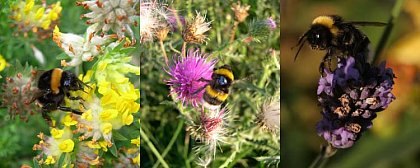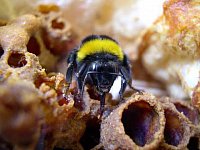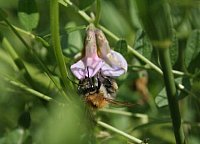From desk to lawn: Bumblebee ecology and population genetics

The Buff-tailed bumblebee (Bombus terrestris) is a short-tongued and polylectic bee that pollinates a wide range of plants. Colonies of this species are big, in comparison to most other bumblebees, consisting of 100-600 individuals (von Hagen 1990). A single colony may produce more than 100 (in extreme cases up to 300 and more in laboratory reared colonies) queens (Beekman & van Stratum 1998, Lopez-Vaamonde 2003), though by far not all colonies reach reproductive stage and often exibit a skewed production of either males or queens (Bourke 1997, Duchateau et al. 2004). Intensively studied in many respects B. terrestris has become a model organism in pollination ecology, sensory physiology, conservation biology and evolutionary research.
Research on Bumblebees


The population ecology of bumblebees is of particular interest because of their ecological importance owing to their ubiquitous occurrence in combination with a high pollination efficiency even under temperate climatic conditions (Bingham & Orthner 1998, Kearns & Thomson 2001). They have even been shown to out-compete honeybees (Apis mellifera) in individual workers pollination efficiency (Westerkamp, 1991; Wilson & Thomson, 1991; Goulson, 2003). Not surprisingly bumblebees have been intensively studied with reference to colony traits (e.g. Beekman & van Stratum 2000, Goulson et al. 2002), pollination (e.g. Fussell & Corbet 1992, Cresswell & Osborne 2004), parasitism (e.g. Imhoof & Schmid-Hempel 1999), flight ranges (e.g. Chapman et al. 2003, Darvill et al. 2004, Knight et al. 2005) and population ecology (e.g. Widmer et al. 1998, Forup & Memmot 2005). Nontheless, more often than not controversary results arose more questions as they answered providing a promising area of research.
Own research

Focussing basically on pollination potential of bumblebees (mainly B. terrestris, but potentially extended to B. lucorum, B. pascuorum, B. lapidarius) our research comprises numerous aspects of bumblebee ecology that are related to pollen transfer. These include foraging behaviour (Herrmann et al. 2007, Wolf & Moritz 2008), flower choice (minoring & majoring, Heinrich 1979, Wolf & Moritz in prep) and learning ability, pollen load analysis (Wolf & Moritz in prep) and genetic structure and spatial dynamics of populations (Kraus et al. in revision) using the combined advantages of classical field methods (e.g. mark-recapture) AND molecular methods (e.g. microsatellite and mt-DNA analysis). Within this general scope we also focus on bumblebee drones and their flight behaviour (Kraus et al. in revision) in relation to gene-transfer within and among bumblebee populations but also to the sofar almost completely neglected drone-mediated pollen-flow. Furthermore, the utilization of genetic information may well provide interesting new insights to the evolutionary forces behind foraging behaviour and population dynamics. For further details on this area of research feel free to write an e-mail.



